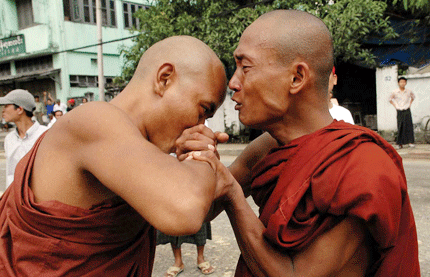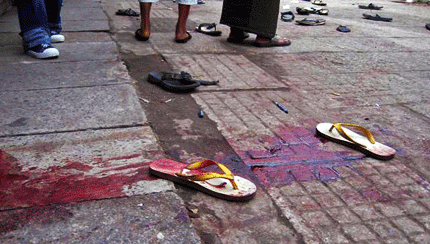A Rangoon Diary
(Page 2 of 3)
 |
| Monks in standoff with security forces [Photo: AP] |
Tuesday, September 25—A scorching and humid heat covers the city. The protest turns out to be more political today. People wear T-shirts with portraits of Suu Kyi and her father, Aung San.
An infirmary has been set up at the Sule Pagoda. Civilians are applying plasters to the blistered feet of monks and are massaging soar legs. Someone announces that members of the National League for Democracy are going to make a speech and loudspeakers are brought. But, at the monks’ request, there won’t be any political speeches.
The monks start marching again. More and more people cheer them. There are shouts of “democracy” and the demonstrators look as if they have already been liberated. Several other foreign photographers are now covering the demonstrations, and during a brief stop dozens of people cheer us and tell us: “Let the world know about our miserable fate. We are not against the soldiers, but against the army’s leaders.”
Around 5 p.m., back at the hotel, I see four military trucks full of soldiers driving towards the Sule Pagoda. A curfew is imposed for 60 days. Repression has started.
 |
| Monks are filled with emotion after the violent crackdown on demonstrators and monks [Photo: Thierry Falise] |
Wednesday, September 26—Shortly before noon, security forces disperse the crowd with tear gas at the Shwedagon Pagoda. About 100 monks manage to gather on a street below the pagoda. In less than an hour, they are met by thousands of people surging from side streets and buses and are welcomed emotionally by their supporters.
People show up in greater numbers than yesterday. They give us, the photographers, water, sweets and protective masks to wear in the case of tear gas attack. People tell us soldiers are shooting directly into the crowds in some parts of Rangoon. Anger and emotion fill the air.
Thursday, September 27—A contact tells me that there is trouble near the Ngwe Kyar Yan monastery, in northern Rangoon. I rush there with two colleagues. Soldiers, policemen and vigilantes block the roads.
The night before, at least 200 monks were brutally arrested in this monastery, and we hear that one died. Hundreds of local people fill the streets, outraged by the arrests. We are told that soldiers opened fire on student protesters in Tamwe Township and that a group of children from a primary school was trapped behind the security forces’ lines.
A man says: “Thirty people have been killed at the Sule Pagoda,” and we rush back downtown. The report turns out to be untrue, but the whole area is infested with soldiers and policemen. I see two large blood stains and dozens of slippers on the road, and I’m told “a Caucasian journalist has been killed.” Later, it’s confirmed that a Japanese photojournalist was shot dead.
At a large intersection near the central railway station, a small group of monks has emerged from nowhere. In a few minutes, thousands of people gather around them and start to walk on a nearby bridge. Soldiers suddenly appear from the bridge’s sides and shoot at us. Run…run! Everyone must run for their lives.
 |
| Bloodstains and abandoned flip-flops mark the site of a violent crackdown against protesters [Photo: AFP] |
Friday, September 28— Crowds defy the military troops in several parts of Rangoon. Groups of people try to reactivate demonstrations but each time, security forces come and separate them. Downtown, dozens of protesters have been arrested, bound and beaten. The troops pursue fleeing people into buildings, singling out those with cameras.
Trucks loaded with troops raid the offices of Burma’s main Internet service provider, Myanmar Info-Tech, located at Rangoon University’s Hlaing campus around noon in an effort to cut all public access to the Internet. The move is in response to the flood of photographs, videos, news reports and e-mails sent out of the country to the international media and the rest of the world by Burmese citizens. Burma is returning to the dark ages.
Saturday, September 29—Security forces are now playing cat and mouse with us foreign journalists.
« previous 1 | 2 | 3 next page »
